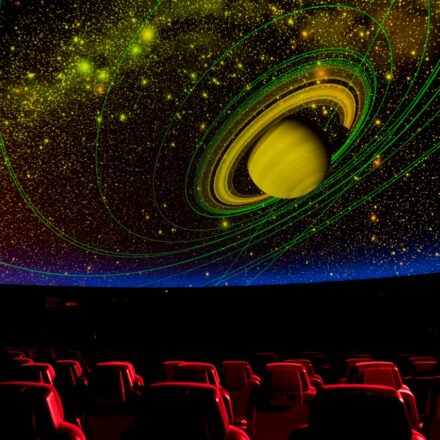By Leslie Lang
Ka’iu Kimura is executive director of ‘Imiloa Astronomy Center, a Hawaiian cultural and astronomy education center in Hilo, Hawaii, that brings together members of the Hawaiian and astronomical communities to share a common vision for the future. ‘Imiloa, which attracts 100,000 visitors per year, focuses on early Polynesian navigation history and knowledge of the night skies, Hawaiian culture and wayfinding today and the growth of astronomy on Hawaii Island, primarily atop the mountain Maunakea.

Polynesians were excellent navigators who traveled the open ocean for thousands of years. Since the 1970s, Hawaiians have been relearning and reviving the art and science of wayfinding and traditional (non-instrument) navigation, which uses an indigenous knowledge of the skies and other observations of nature.
Kimura, a native Hawaiian, was asked to help plan ‘Imiloa while she was a graduate student studying Hawaiian language at the University of Hawaii Hilo. She holds a leadership role at the UH Hilo College of Hawaiian Language, helped reestablish the Hawaii Island Native Hawaiian Chamber of Commerce, and has been an Omidyar Fellow and Pacific Century Fellow.
Kimura, who Hawaii Business magazine included on its “20 for the next 20″ list of people to watch, discusses the challenges and rewards of directing a center that highlights both science and culture for its local community.
How would you describe the ‘Imiloa Astronomy Center?
‘Imiloa is a place that shares stories of connection to place, specifically Maunakea. Because this is a Hawaiian place, there are Hawaiian connections to Maunakea. So we start with those connections to learn about the mountain’s natural features and uniqueness, as well as its cultural and lineal connections through the Hawaiian community, and then onto more recent connections through the modern astronomical research that’s taking place on Maunakea. ‘Imiloa aspires to be a place that shares and grows those stories and connections in and amongst our local and global communities.
Culture and science are clashing when it comes to the Thirty Meter Telescope (TMT) being built on Maunakea. As you know, the TMT is a large telescope that will let scientists see deeper into space. Some Hawaiians and activists oppose its construction on Maunakea, saying the land is sacred. What role does ‘Imiloa take in this issue?
‘Imiloa’s position is to be a place of sharing and learning, and it’s up to individuals and the community to formulate their own opinions. But where I hope we’re helpful is in providing opportunities where you can get actual, factual and direct shared learning experiences on the TMT, as opposed to hearsay or assumptions. That’s the position we’ve taken on anything, really—to be a place to come, learn and have hard discussions around issues that are contentious, as well as issues that aren’t.
We’ve brought different knowledge holders together—whether they were people with Hawaiian cultural knowledge, language experts or astronomical experts from Hawaii and from around the world—to sit and talk about cultural and local ways of connecting to the skies, along with some of the scientific research and scientific communities’ ways of looking at the skies.

What are other ways that ‘Imiloa helps bridge the cultural and scientific communities?
In our A Hua He Inoa program, we take fluent Hawaiian language speakers—young people, high schoolers, college-age students, and teachers out there in Hawaiian-medium and Hawaiian immersion schools—and investigate our Hawaiian cosmology and the origins of our universe as documented in our Hawaiian chants and records. Then these language speakers name major discoveries coming from Maunakea telescopes in our Hawaiian language.
As a result of this, we’ve had people from the astronomy community take Hawaiian language classes and want to learn more about and better respect and understand the Hawaiian perspective.
I think the astronomy community is realizing the importance of the fact that the International Astronomical Union is now adopting Hawaiian names and recording them as such in the official records. They’re even allowing us to write them bilingually, in English and Hawaiian, probably the first indigenous language recorded in those annals of knowledge.
What do you think the kupuna [Hawaiian ancestors] of a couple of hundred years ago might think about astronomy and the TMT being sited on Maunakea?
As with any community, there will always be varying opinions. I am just beginning to learn about the depth of knowledge and understanding our kupuna had about the creation of our universe. [The ancient Hawaiian creation chant, the Kumulipo, is more than 2,000 lines long and describes the creation of the universe.] It’s pretty astounding, and I’m only beginning to scratch the surface.
I imagine that some would feel like these observatories could help further affirm, confirm or expand that understanding described generations ago, hundreds of years ago, with no instrumentation. I can see utilizing these instruments to help create different research agendas to help further explore what has already been documented in our traditional knowledge and chant.
Tell me more about ‘Imiloa being both a science center and an indigenous and cultural knowledge center.
We are partnering with many science centers, museums and planetariums around the world to further explore how to strengthen relationships between indigenous and local communities. Also, to strengthen the educational missions of those places to be very inclusive and maybe even advocate for strengthening indigenous knowledge and educational opportunities through indigenous knowledge.

That’s something we find fun because back when we were building ‘Imiloa, there was no roadmap on how to build a science center that had a cultural mission. In fact, it was pretty challenging to have a science center that started with that premise. Many people wanted the Hawaiian culture to just be a dressing on the walls, and the educational content to have science as the perspective.
We’ve tried to dispel that and say that there are multiple ways of knowing. And by these multiple ways coming together, you can create an even better understanding and perhaps even better science agendas and stronger cultural agendas.
What’s next for ‘Imiloa?
Recently, we premiered a new planetarium collection of seven short films that talk about how different cultural communities connect to the night skies. That, to me, is really what ‘Imiloa’s mission is—to help other people recognize the importance of local and indigenous perspectives on astronomy and the skies.
‘Imiloa led this project and worked with the California Academy of Science. The films will be available for free to planetariums around the world that would like to hold conversations about cultural knowledge.
It’s been fun trying to advocate for strengthening relationships between indigenous and local communities. Not at all to take credit, but ‘Imiloa has contributed to a national agenda to bring indigenous communities and indigenous knowledge, particularly with astronomy, to the forefront.
For the first time ever, the Astro2020 decadal survey, a document that sets up U.S. astronomy priorities for the next 10 years, includes a report on the state of the profession that talks about how U.S. astronomy needs to do a better job of being reflective of the communities it does research in. I think that’s a step in the right direction.
Lead image courtesy of ‘Imiloa Astronomy Center

